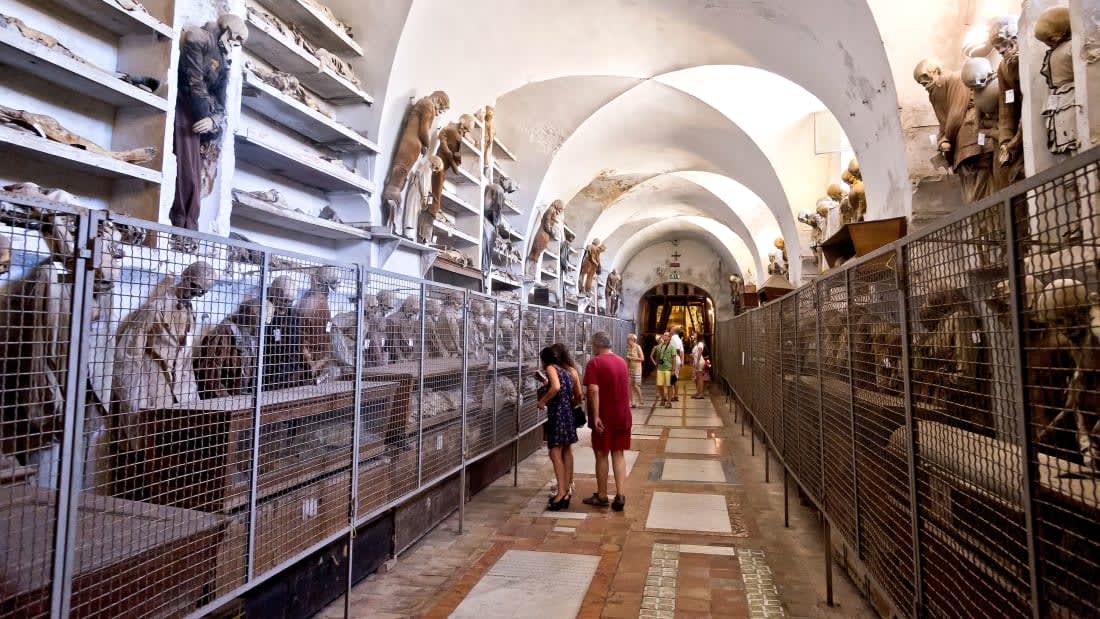دبي، الإمارات العربية المتحدة (CNN) -- تسعى مجموعة من العلماء إلى معرفة السبب الكامن وراء تحنيط عشرات الأطفال، ثم دفنهم في سراديب الموت العائدة إلى دير قائم على الجزيرة الإيطالية، صقلية.
وتقود كيرستي سكوايرز الأستاذة المساعدة في علم الآثار الحيوية في جامعة ستافوردشاير، في المملكة المتحدة، أوّل دراسة شاملة للأطفال المحنّطين، ويبدأ أول عمل ميداني مطلع الأسبوع المقبل.
وفي سراديب الموت التابعة لدير الكبوشيين في باليرمو شمال صقلية، الذي يشكل معلمًا سياحيًا مرعبًا، سيحلّل الباحثون بقايا 41 طفلًا دفنوا في إحدى المدافن المخصصة للأطفال، رغم أنّ مجموع المدفونين في هذه السراديب يصل إلى 163 طفلًا.
وقالت سكوايرز لـCNN الخميس: "نحن نرغب في معرفة حياة هؤلاء الأفراد، وصحتهم، ونموّهم، وما إلى ذلك"، موضحة: "نريد مقارنة البيانات الحيوية مع العديد من الجوانب الثقافية حينها".
وأضافت سكوايرز أنّ الأطفال المحنّطين يرتدون ملابسهم كاملة، ووُضع بعضهم في أسرّتهم وآخرين على كراسٍ، فيما يأخذ البعض الآخر وضعية الوقوف بمساعدة عصا، كما سيحلّل الباحثون معنى القطع الأثرية المستخدمة.

وتُعتبر المعلومات المتعلّقة بهؤلاء الأطفال المدفونين بين عامي 1787 و1880 قليلة، وهم يشكّلون جزءًا من مجموعة كبيرة من رفات أفراد محنطين في القارة الأوروبية، تتضمن 1284 جثة.
وقالت سكوايرز: "نعلم أنهم ينتمون إلى عائلات الطبقة الوسطى، لأنّ طقوس التحنيط كانت تمارس لدى الفئات الأكثر ثراءً، مثل النبلاء، والطبقة المتوسطة، ورجال الدين".
وأوضحت: "نعلم أنّهم لا ينتمون إلى الطبقة الأفقر في المجتمع، لكن هذا كل ما نعرفه إلى الآن". وأضافت: "لكن لِمَ لَمْ يُدفنوا إسوة بالآخرين"؟
وجاء في بيان صحفي أصدرته جامعة ستافوردشاير، أنّ الفريق سيستخدم تقنية التصوير بالأشعة السينيّة، لأنّها طريقة غير مؤذية للاعتبارات الأخلاقية، خلافًا لتشريح بقايا الجثث البشرية.
وقالت سكوايرز: "إننا نستخدم آلة أشعة سينيّة محمولة لأخذ صور شعاعية تساعدنا على تقدير أعمار الأطفال، استنادًا إلى الأسنان ونموّها، ودمج العظام"، لافتة إلى أنها ستبحث عن مؤشرات للمرض.
وسيجري الباحثون بالمجمل 574 صورة شعاعية، أو 14 صورة لكل مومياء، لتضمين البيانات في ملف الأطفال البيولوجي، ومعرفة إذا شمل التحنيط من هم في سنّ أو من جنس محدّد.
ووفقًا لما جاء على موقع المشروع، ستُستخدم هذه البيانات للكشف عن وجود عيوب خلال النمو، ومؤشّرات الإجهاد، والآفات المرضية، بهدف معرفة الحالة الصحية ونمط الحياة الذي اختبره الأطفال حينها.
وبحسب سكوايرز، فإن ممارسة التحنيط في سراديب الموت تعود إلى العام 1599، واستمرت حتى أوائل القرن العشرين. وكانت تنظر الطبقة الوسطى إلى هذا الطقس على أنّه "طريقة للحفاظ على الشخصية الاجتماعية حيّة بعد الموت"، مع تردّد العائلات على زيارة رُفات ذويهم المدفونين.
ويشارك سكوايرز في سراديب الموت هذه، الباحث داريو بيومبينو-ماسكالي من جامعة فيلنيوس في ليتوانيا، بالإضافة إلى مصوّرَين شعاعيّين وفنان، حيث يمضون أسبوعًا بحثًا في سجلات الأموات. ومن المتوقع أن تتطلب نتائج هذا البحث عدة أشهر قبل نشرها.
